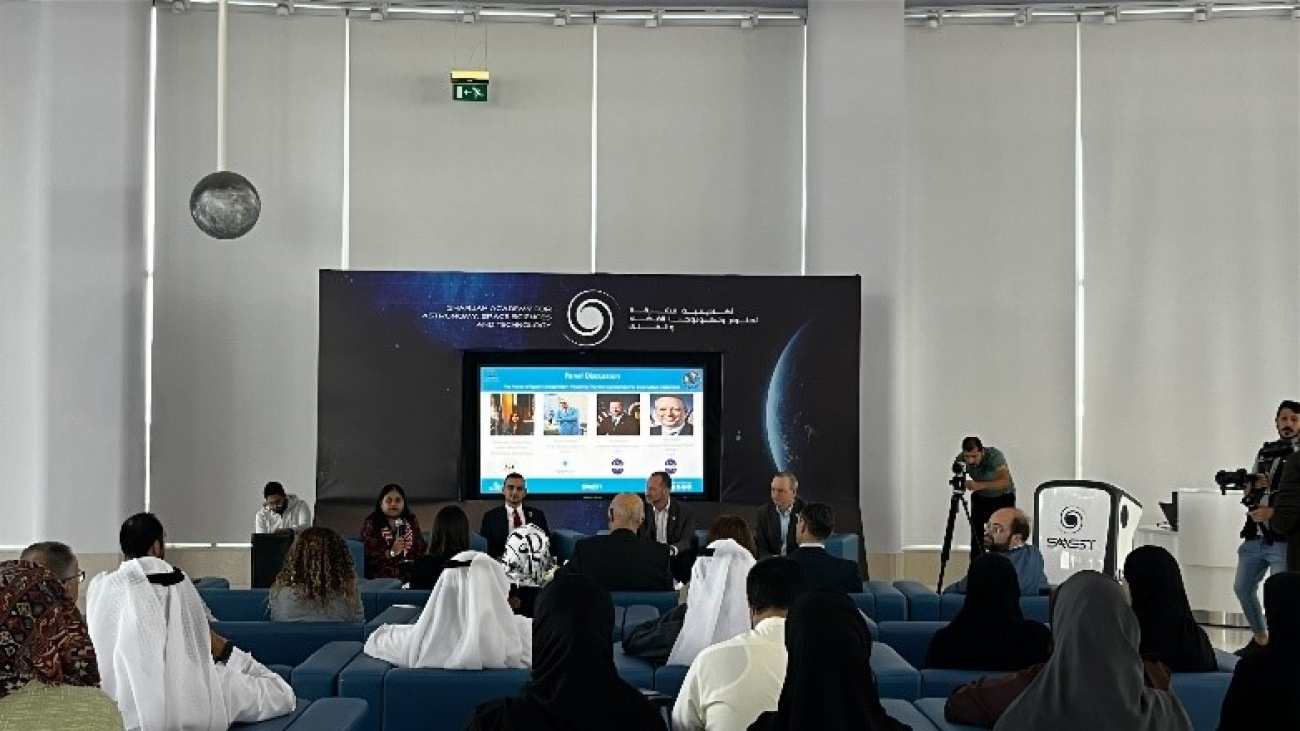the Sharjah Academy for Astronomy, Space Sciences, and Technology organized a discussion panel with two of NASA’s Gateway officials: Dr. Sean Fuller (NASA Gateway International Partner Manager) and Dr. Jon Olansen (NASA Gateway Program Manager).
The U.S. Consulate in Dubai initiated the program through the U.S. Mission representative on U.S.-UAE bilateral space cooperation and mission support for STEM/Space initiatives. Mrs. Daleya Uddin (U.S. Consulate, Public Affairs Officer) and Eng. Yousuf Faroukh from SAASST CubeSat Laboratory arranged for the panel to be held at SAASST on Jan. 25, 2024.
Prof. Hamid Al-Naimiy, the University of Sharjah Chancellor, and the SAASST Director attended the panel discussion and gave some introductory notes about UoS and SAASST.
Gateway is vital for the NASA-led Artemis missions to return to the Moon and chart a path for the first human missions to Mars. The small space station will be a multi-purpose outpost orbiting the Moon, providing essential support for lunar surface missions, a science destination, and a staging point for further deep space exploration. NASA is working with commercial and international partners to establish Gateway.
NASA and the Mohammed bin Rashid Space Centre (MBRSC) of the United Arab Emirates (UAE) announced Sunday plans for the space center to provide an airlock for Gateway, humanity’s first space station that will orbit the Moon. The lunar space station will support NASA’s missions for long-term exploration of the Moon under Artemis for the benefit of all.
“As chair of the National Space Council, I have prioritized enhancing international cooperation in space. Today’s announcement and partnership between the United States and the United Arab Emirates advances this important work. By combining our resources, scientific capacity, and technical skill, the U.S. and UAE will further our collective vision for space and ensure it presents extraordinary opportunities for everyone here on Earth,” said Vice President Kamala Harris.
Under a new implementing arrangement expanding their human spaceflight collaboration with NASA through Gateway, MBRSC will provide Gateway’s Crew and Science Airlock module and a UAE astronaut to fly to the lunar space station on a future Artemis mission.
“The United States and the United Arab Emirates are marking a historic moment in our nations’ collaboration in space and the future of human space exploration,” said NASA Administrator Bill Nelson. “We are in a new era of exploration through Artemis – strengthened by the peaceful and international space exploration. The UAE’s provision of the airlock to Gateway will allow astronauts to conduct groundbreaking science in deep space and prepare to one day send humanity to Mars.”
In addition to operating the airlock, MBRSC also will provide engineering support for the life of the lunar space station. The airlock will allow crew and science research transfers to and from the habitable environment of Gateway’s pressurized crew modules to the vacuum of space. These transfers will support broader science in the deep space environment and Gateway maintenance.
Gateway will support sustained exploration and research in deep space and provide a home for astronauts to live and work, including a staging point for lunar surface missions and an opportunity to conduct spacewalks while orbiting the Moon.
NASA’s Artemis program is the most diverse and broad coalition of nations in human exploration in deep space. In collaboration with the CSA (Canadian Space Agency), ESA (European Space Agency), JAXA (Japan Aerospace Exploration Agency), and now the MBRSC, NASA will return humans to the lunar surface for scientific discovery and chart a path for the first human missions to Mars.



